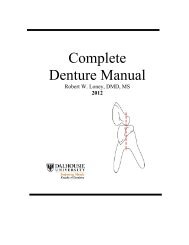RPD Manual 11 - Removable Prosthodontics - Dalhousie University
RPD Manual 11 - Removable Prosthodontics - Dalhousie University
RPD Manual 11 - Removable Prosthodontics - Dalhousie University
Create successful ePaper yourself
Turn your PDF publications into a flip-book with our unique Google optimized e-Paper software.
Functions<br />
Materials<br />
Denture Bases and Replacement Denture Teeth<br />
1. Support and retention of the denture teeth<br />
2. Transmission of stresses to oral tissues - maximal coverage within anatomic<br />
limitations, accurate reproduction of supporting tissues<br />
3. Improve esthetics<br />
1. Acrylic Resin Bases<br />
Denture Bases - 59<br />
Acrylic resin bases are the most common types used in removable partial dentures. They<br />
should be routinely used in distal extension cases to allow for relining of the base to<br />
maintain mucosal support. Acrylic resin should make a butt joint (or slightly undercut<br />
joint) with the major and minor connectors. If the resin is brought to a feather edge, it will<br />
distort, break or separate from the framework, causing injury to the underlying soft<br />
tissues.<br />
Advantages:<br />
a. ability to reline the base as the supporting tissues change<br />
b. esthetically superior to metal bases<br />
c. ease of repair<br />
Disadvantages:<br />
a. dimensional stability less than metal bases - warpage<br />
b. lower strength than metal - long spans<br />
c. porous - hygiene<br />
d. low thermal conductivity<br />
2. Metal Bases<br />
Metal bases can be used wherever acrylic resin bases are used. However, the esthetic<br />
result can be compromised unless the metal can be veneered with sufficient thickness of<br />
acrylic. If an insufficient veneer is used, a greyish hue of the underlying metal becomes<br />
visible. Where single tooth replacements are placed, there is often insufficient room to<br />
fabricate a retentive gridwork. A full metal base is often used in these instances. When<br />
this type of base is used, denture teeth are attached to the framework with acrylic resin via<br />
beading or retentive posts on the metal surface. In some rare instances, a tooth-bounded<br />
edentulous span may exist that is too small for placement of a denture tooth. When this<br />
type of edentulous space is encountered, it is can be completely filled with the framework<br />
metal, if it will not compromise esthetics.<br />
Metal bases cannot be relined, so they are generally not used for tooth-tissue borne<br />
removable partial dentures, or in areas where teeth have been removed within 12 months<br />
(resorption will still be occurring at an increased rate and relining will be usually be<br />
required).















